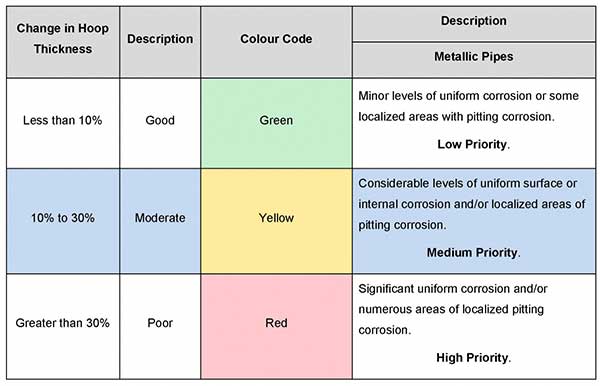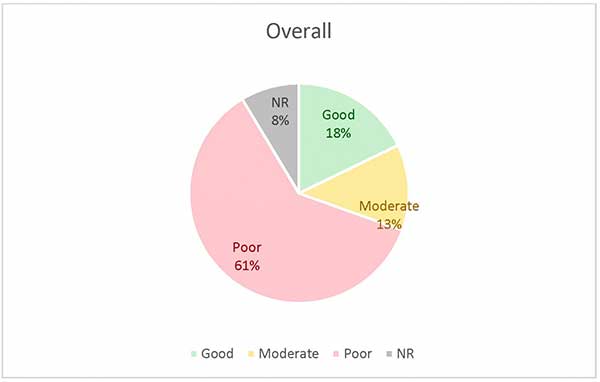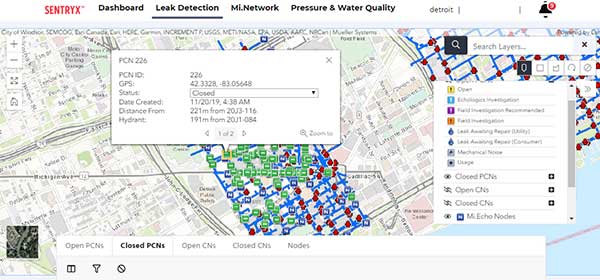Detroit Doubles Down on Assessment of Water Infrastructure
Date:
Publication:
Many water utilities across North America are struggling with budgeting and managing the required renewal plans of their aging buried water assets that have reached the end of their service life. Spending time and money on assessing the condition of this buried infrastructure before breaking ground is proving to be the most prudent spend.
The City of Detroit Water and Sewerage Department (DWSD) developed a holistic approach to optimize the assessment of their most vulnerable watermains.
Under a capital improvement program management structure, DWSD and AECOM performed an initial desktop assessment, to prioritize the City’s water main renewal program based on risk. This initial assessment was primarily focused on water main failure/break history coupled with additional parameters such as; hydraulic capacity, criticality, and surrounding parallel asset infrastructure renewal efforts (i.e. – storm/sanitary sewer or road renewal projects) to characterize consequence of failure, likelihood of failure and rehabilitation opportunity.

“The desktop assessment model, allows us to identify critical mains, prioritize mains where evidence-based condition assessment could be undertaken to identify rehabilitation needs and one of the assessment technologies we utilized was Echologics technology from Mueller,” says AECOM vice president and technical director Devan Thomas.
Thirty-one miles of cast and ductile iron water mains in various neighborhoods within the City of Detroit were identified for Echologics assessment and potentially requiring rehabilitation or replacement.
An Echologics field team was brought onsite to use the ePulse technology that assesses the integrity of the pipes without breaking ground or any disruption to the service. This technology can measure the average minimum remaining wall thickness of ductile and cast-iron cast iron, and the average minimum remaining wall stiffness of asbestos cement and concrete water pipes over a measured segment (generally between 250 to 650 ft). ePulse condition assessment is performed by bracketing a section of pipe between two sensors that are attached to existing appurtenances on the pipe. An out-of-bracket noise is then created by tapping on a hydrant/valve or flowing a hydrant. As a pipe degrades the velocity at which sound waves travel through the pipe decreases. The field team measures the distance between the two sensors and proprietary software calculates the time taken for the acoustic signal to propagate between the two sensors, while also taking into account the pipe and water properties.
In total, 348 pipe segments with an average length of 478 ft were assessed for the remaining minimum structural wall thickness and then compared to the original nominal wall thickness to determine the average structural wall loss. Results were categorized by condition into good, moderate or poor as per the table below:
Figure 2 below shows the results breakdown by condition category for the entire project scope. The pie chart shows that the majority, 61 percent of pipe tested, was identified to be in poor condition, while 17 percent was identified to be in good condition and 13 percent in moderate condition.

Figure 3 below shows the distribution of condition assessment results in specific neighborhoods for all of the pipe tested. As shown in the graph, the largest bin of pipe distance tested per area was found to be “poor condition” (greater than 30 percent loss in structural wall thickness).

Anil Gosine Program Manager of the City of Detroit Water and Sewerage Department said, “We were pleased that both the desktop modelling and ePulse assessment did not require any excavating, external traffic control or interruption to the water service,” said Anil Gosine, program manager of the City of Detroit Water and Sewerage Department.
By identifying and subsequently validating through the ePulse assessment the most critical 19.3 miles of pipe, the department can now confidently proceed with allocating budget and replacing these sections based on sound data. “As asset owners we needed to make the shift from a reactive mentality to a proactive one by using tools available to us and use leak detection and condition assessment technologies to narrow down the areas that need the most attention,” Gosine said.
RELATED: A Sound Approach to Evaluating NRW Loss and Aging Pipelines
“During the testing for condition assessment they also identified 14 leaks, many of which were found in abandoned homes and could have continued undetected for quite some time,” said Gosine . Stopping water loss is an instant savings, but as leaks persist they can eventually result in far greater damage with emergency repairs that can be costly and disruptive.
In addition to having utilized the ePulse assessment technology, DWSD has also deployed EchoShore-DX leak permanent detection monitoring system in other parts of its waste distribution system. This technology incorporates the latest generation of acoustic sensors capable of identifying extremely faint acoustical noises emitted by leaks before they become detectable by conventional methods.
The monitoring system consists of a network of leak detection sensors referred to as nodes . A node incorporates a cellular communications radio, GPS locator, antenna, acoustic sensor, on-board processor, and a battery power source. Each node is housed in a custom manufactured cast-iron fire hydrant pumper nozzle cap, replacing existing fire hydrant pumper nozzle caps.

The nodes are spaced at an average of 500-900 foot intervals and can detect leaks over a distance of up to 1,100 feet . The system scans the monitored area for the presence of leaks daily . The nodes record acoustic data from the pipelines before generating and wirelessly transmitting recorded sound files over the cellular or radio network to the head-end host software system, which is a cloud-based internet solution.
Leak monitoring system operators can view the locations of leaks and review historic data to determine if immediate repairs need to be made . Detected leaks are easily viewed by water operators through the web user interface . Figure 4 shows an example of the web user interface.
Based on the findings of the condition assessment program, DWSD proceeded with a risk model that captures the water system assets city-wide and has completed water design for some neighbourhoods that are now scheduled to be in construction in 2020. “The ePulse data provided insight and a better understanding of remaining pipe wall thickness of water mains that allowed us to refine our intervention techniques that led to significant cost savings. This will continue to allow us to divert capital spending to more appropriate candidates that will continue to lower water main risk across Detroit,” concluded Gosine.
Author: Michael Livermore
Click here to read the full article in Trenchless Technology Magazine